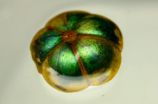(Press-News.org) Red coloration—historically seen as costly in vertebrates—might represent some physiological benefit after all, according to research published in the journal Physiological and Biochemical Zoology.
Pheomelanin, which is responsible for red hair and freckles in humans and orange and chestnut coloration in other animals, is known to increase the damage to skin cells and melanoma risk when present in large amounts. Furthermore, its creation involves the consumption of glutathione, a beneficial antioxidant.
In an attempt to unearth the factors favoring the evolution of pheomelanin in spite of its costs, Ismael Galván and Anders P. Møller of the University of Paris-Sud examined the survival from one breeding season to the next of a wild European population of barn swallows, as well as the annual survival rates of 58 species of American birds.
A recent hypothesis claims that the consumption of cysteine (a component of glutathione) that occurs when pheomelanin is produced can be beneficial under conditions of low stress. Cysteine, which is mainly acquired through diet, can be toxic at high levels, so the production of pheomelanin may help to sequester excess quantities of this amino acid.
Galván and Møller measured birds' blood levels of uric acid and analyzed the coloration of their chestnut throat feathers (an indication of pheomelanin content). When they compared birds that had similar uric acid levels (and therefore similar capacities to excrete excess amino acids), they found that both the European barn swallows and the American birds with larger amounts of pheomelanin in their feathers survived better.
This study is the first to propose that the costs/benefits of pheomelanin may depend on prevailing environmental conditions, and its results suggest that the production of this pigment may even be beneficial in some circumstances. Given that all higher vertebrates, including humans, present pheomelanin in skin, pelage, and plumage, Galván and Møller's findings increase the scant current knowledge on the physiological consequences of pheomelanin and open new avenues for research that will help us understand the evolution of pigmentation.
###
Ismael Galván and Anders P. Møller, "Pheomelanin-Based Plumage Coloration Predicts Survival Rates in Birds." Physiological and Biochemical Zoology 86:2 (March/April 2013). Available ahead of print at http://www.jstor.org/stable/10.1086/668871.
Physiological and Biochemical Zoology primarily publishes original research papers in animal physiology and biochemistry, with a specific emphasis on studies that address the ecological and/or evolutionary aspects of physiological and biochemical mechanisms. Studies at all levels of biological organization from the molecular to the whole organism are welcome, and work that integrates levels of organization to address important questions in behavioral, ecological, evolutionary, or comparative physiology is particularly encouraged.
Contact: Ismael Galván/ismael.galvan@u-psud.fr; Emily Murphy/773-702-7521/emurphy@press.uchicago.edu
Why are there redheads? Birds might hold the clues
2013-01-29
ELSE PRESS RELEASES FROM THIS DATE:
AGU Journal Highlights -- Jan. 28, 2013
2013-01-29
The following highlights summarize research papers that have been recently published in Geophysical Research Letters (GRL), Water Resources Research, Journal of Geophysical Research – Planets (JGR-E), Journal of Geophysical Research – Oceans (JGR-C), and Journal of Geophysical Research-Biogeosciences (JGR-G).
In this release:
1. Io's volcanism controls Jupiter's magnetospheric activity
2. Projected U.S. water use likely to increase as climate warms
3. Mercury's crust likely made of magnesium-rich basalt
4. Assessing the Great Whirl, despite all the pirates
5. Tracing ...
Bioinspired fibers change color when stretched
2013-01-29
Cambridge, Mass. – January 28, 2013 - A team of materials scientists at Harvard University and the University of Exeter, UK, have invented a new fiber that changes color when stretched. Inspired by nature, the researchers identified and replicated the unique structural elements that create the bright iridescent blue color of a tropical plant's fruit.
The multilayered fiber, described today in the journal Advanced Materials, could lend itself to the creation of smart fabrics that visibly react to heat or pressure.
"Our new fiber is based on a structure we found in nature, ...
Innovative uses of nanotechnology in food and agriculture
2013-01-29
New Rochelle, NY, January 28, 2013—The U.S. Department of Agriculture (USDA) invests nearly $10 million a year to support about 250 nanoscale science and engineering projects that could lead to revolutionary advances in agriculture and food systems. Examples of current projects in development are presented in a Special Research Section published in Industrial Biotechnology, a peer-reviewed journal from Mary Ann Liebert Inc., publishers. The articles are available on the Industrial Biotechnology website.
In their introductory article, "Overview: Nanoscale Science and ...
Skin, soft tissue infections succumb to blue light
2013-01-29
Blue light can selectively eradicate Pseudomonas aeruginosa infections of the skin and soft tissues, while preserving the outermost layer of skin, according to a proof-of-principle study led by Michael R. Hamblin of the Massachusetts General Hospital, and the Harvard Medical School, Boston. The research is published online ahead of print in the journal Antimicrobial Agents and Chemotherapy
"Blue light is a potential non-toxic, non-antibiotic approach for treating skin and soft tissue infections, especially those caused by antibiotic resistant pathogens," says Hamblin. ...
Injecting botox into stomach does not promote weight loss
2013-01-29
Bethesda, MD (Jan. 28, 2013) – Despite conflicting data in support of the practice, some overweight Americans looking for an easy fix have turned to gastric botox injections to help them lose weight. This month in Clinical Gastroenterology and Hepatology, the official clinical practice journal of the American Gastroenterological Association, researchers from the Mayo Clinic publish a definitive study finding that Botox doesn't promote weight loss.
Injecting botulinum toxin A (BTA), or Botox, into the stomach had been believed to delay emptying of the stomach, increase ...
New study shows stable fisher population in the Southern Sierra Nevada
2013-01-29
ARCATA, Calif.—After experiencing years of population decline on the West Coast, a recent study examining fisher populations found that—at least in the southern Sierra Nevada—the animal's numbers appear to be stable.
Scientists from the U.S. Forest Service's Pacific Southwest Research Station (PSW) and the Pacific Southwest Region collaborated to monitor the distribution of fishers across a 7,606-square-mile area in the southern Sierra Nevada. They used baited track-plate stations—an enclosure where the fisher leaves a sooted track print as it walks through—at 223 locations ...
Using Twitter to track the flu: A better way to screen the Tweets
2013-01-29
Sifting through social media messages has become a popular way to track when and where flu cases occur, but a key hurdle hampers the process: how to identify flu-infection tweets. Some tweets are posted by people who have been sick with the virus, while others come from folks who are merely talking about the illness. If you are tracking actual flu cases, such conversations about the flu in general can skew the results.
To address this problem, Johns Hopkins computer scientists and researchers in the university's School of Medicine have developed a new tweet-screening ...
Climate change projected to alter Indiana bat maternity range
2013-01-29
Research by US Forest Service scientists forecasts profound changes over the next 50 years in the summer range of the endangered Indiana bat. In an article published in the journal Ecology and Evolution, Forest Service Southern Research Station researchers Susan Loeb and Eric Winters discuss the findings of one of the first studies designed to forecast the responses of a temperate zone bat species to climate change.
The researchers modeled the current maternity distribution of Indiana bats and then modeled future distributions based on four different climate change scenarios. ...
New look at cell membrane reveals surprising organization
2013-01-29
LIVERMORE, CALIF. — A new way of looking at a cell's surface reveals the distribution of small molecules in the cell membrane, changing the understanding of its organization.
A novel imaging study by researchers from Lawrence Livermore National Laboratory, the University of Illinois and the National Institutes of Health revealed some unexpected relationships among molecules within cell membranes.
Their findings provide a new way of studying cell structure and ultimately its function.
Led by Mary Kraft of the University of Illinois, Peter Weber of Lawrence Livermore ...
Eating bright-colored fruits and vegetables may prevent or delay ALS
2013-01-29
New research suggests that increased consumption of foods containing colorful carotenoids, particularly beta-carotene and lutein, may prevent or delay the onset of amyotrophic lateral sclerosis (ALS). The study, published by Wiley in Annals of Neurology, a journal of the American Neurological Association and Child Neurology Society, found that diets high in lycopene, beta-cryptoxanthin, and vitamin C did not reduce ALS risk.
Carotenoids give fruits and vegetables their bright orange, red, or yellow colors, and are a source of dietary vitamin A. Prior studies report that ...


